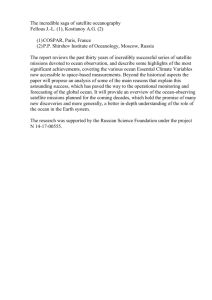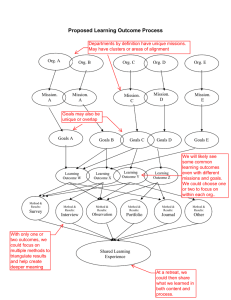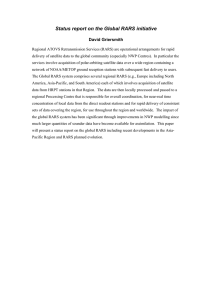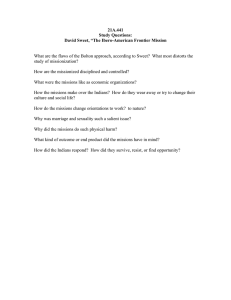ITSC-17 WORKING GROUP ON INTERNATIONAL ISSUES AND FUTURE SYSTEMS
advertisement
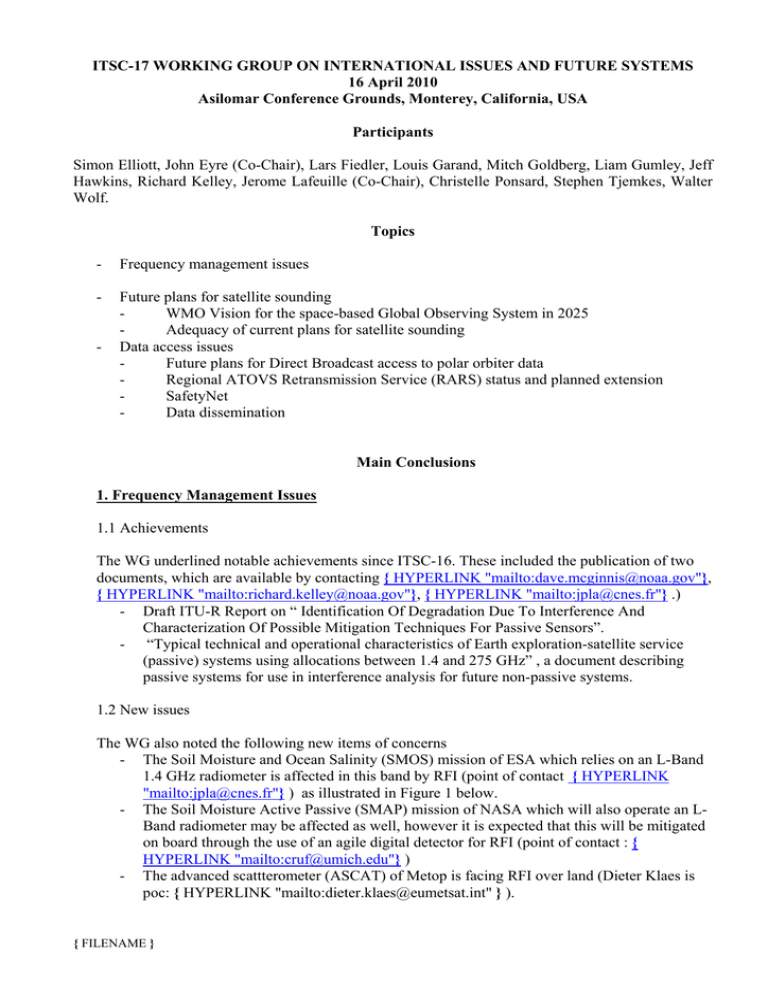
ITSC-17 WORKING GROUP ON INTERNATIONAL ISSUES AND FUTURE SYSTEMS
16 April 2010
Asilomar Conference Grounds, Monterey, California, USA
Participants
Simon Elliott, John Eyre (Co-Chair), Lars Fiedler, Louis Garand, Mitch Goldberg, Liam Gumley, Jeff
Hawkins, Richard Kelley, Jerome Lafeuille (Co-Chair), Christelle Ponsard, Stephen Tjemkes, Walter
Wolf.
Topics
-
Frequency management issues
-
Future plans for satellite sounding
WMO Vision for the space-based Global Observing System in 2025
Adequacy of current plans for satellite sounding
Data access issues
Future plans for Direct Broadcast access to polar orbiter data
Regional ATOVS Retransmission Service (RARS) status and planned extension
SafetyNet
Data dissemination
-
Main Conclusions
1. Frequency Management Issues
1.1 Achievements
The WG underlined notable achievements since ITSC-16. These included the publication of two
documents, which are available by contacting { HYPERLINK "mailto:dave.mcginnis@noaa.gov"},
{ HYPERLINK "mailto:richard.kelley@noaa.gov"}, { HYPERLINK "mailto:jpla@cnes.fr"} .)
- Draft ITU-R Report on “ Identification Of Degradation Due To Interference And
Characterization Of Possible Mitigation Techniques For Passive Sensors”.
- “Typical technical and operational characteristics of Earth exploration-satellite service
(passive) systems using allocations between 1.4 and 275 GHz” , a document describing
passive systems for use in interference analysis for future non-passive systems.
1.2 New issues
The WG also noted the following new items of concerns
- The Soil Moisture and Ocean Salinity (SMOS) mission of ESA which relies on an L-Band
1.4 GHz radiometer is affected in this band by RFI (point of contact { HYPERLINK
"mailto:jpla@cnes.fr"} ) as illustrated in Figure 1 below.
- The Soil Moisture Active Passive (SMAP) mission of NASA which will also operate an LBand radiometer may be affected as well, however it is expected that this will be mitigated
on board through the use of an agile digital detector for RFI (point of contact : {
HYPERLINK "mailto:cruf@umich.edu"} )
- The advanced scattterometer (ASCAT) of Metop is facing RFI over land (Dieter Klaes is
poc: { HYPERLINK "mailto:dieter.klaes@eumetsat.int" } ).
{ FILENAME }
Figure { SEQ "Illustration" \*Arabic }: SMOS image of strong RFI probability
1.3 Use of the spectrum above 275 GHz
An agenda item for the World Radiocommunications Conference in 2012 calls for a review and
possible revision of the Radio Regulations (RR) No. 5.565, to address existing and projected
requirements between 275 GHz and 3 000 GHz for the Earth exploration-satellite service (EESS)
and space research service (SRS).
It is important for ITWG membership to review its requirements for use of the spectrum in the
band between 275 and 3000 GHz and make their ideas know to the international community.
Interested member can contact { HYPERLINK "mailto:dave.mcginnis@noaa.gov"}, {
HYPERLINK "mailto:richard.kelley@noaa.gov"}, { HYPERLINK "mailto:jpla@cnes.fr"}.
1.4 Emitter registry
There are existing international spectrum allocations which guide frequency band usage and
delineate restrictions placed on such use. That being said there is recognition, among the
environmental satellite community, of instances in which emitters now or in the future will destroy
data of interest to this community. An international registry of emitters would provide advance
notification for future environmental satellite missions. It is proposed that a discussion of such a
registry be held within appropriate WMO (??) entities. Such a registry could contain information
on emitter locations, RF characteristics, duty cycles, and anticipated time frame of emitter
existence.
N.B. There is a much smaller scale effort called Radiofrequency Interference Survey of the Earth
(RISE).
2. Vision for the space-based GOS in 2025 and adequacy of current plans
The WG was briefed on the Vision for the GOS in 2025, that was finalized and adopted by the WMO
Commission for Basic Systems (CBS) in April 2009 and subsequently approved by the 61st WMO
Executive Council in June 2009. It is now available online as a reference document (See: {
HYPERLINK
"http://www.wmo.int/pages/prog/www/OSY/WorkingStructure/documents/CBS{
2009_Vision-GOS-2025.pdf" }) and is attached to this report.
The Vision provides a description of both the surface and space segments of the Global Observing
System as a goal to guide the evolution of this system in the coming two decades. The vision addresses
general features such as the adaptation to evolving user requirements, the integration of its various
components, the expanded range of observations and parameters to be handled, the need for increased
standardization, interoperability, and quality control. As concerns space-based observation, the vision
stresses the trend towards higher spatial, temporal and spectral resolutions, the need to improve
availability and timeliness, and to ensure accurate calibration and global intercalibration. The spacebased component of the GOS is anticipated to increasingly rely on partnership among operational and
R&D satellite operating agencies. The vision not only foresees the continuation and enhancement of
heritage missions in geostationary and in sun-synchronous orbit, but also calls for the transition to
operational status of a range of missions on diversified orbit configurations that, in the past, have been
only pursued with a research or demonstration purpose. These included for instance missions dedicated
to the monitoring of Essential Climate Variables such as sea surface height, Earth radiation budget, or
atmospheric composition.
The WG noted that planned satellites in Highly Elliptical Orbit (HEO) would have advanced imagers.
A limited number of water vapour and temperature channels are suitable for assimilation at high (15
mn) temporal and spatial (2 km) resolution.
The WG highlighted and reinforced the three types of satellite sounding that are called for by the
vision:
- LEO sun-synchronous MW and hyperspectral IR observation from 3 orbital planes (am, pm,
early morning)
- Geostationary hyperspectral IR
- Radio-occultation (RO) sounding
The WG reviewed the adequacy of current satellite plans with respect to these sounding missions from
the mid-morning, afternoon, early morning and geostationary orbits, as well as the Radio-Occultation
constellation plans.
Mid-morning and afternoon orbits
The WG felt confident that the morning orbit was well covered by Metop, and complemented by FY-3
that in future would carry an IR hyperspectral sounder. It also noted the ongoing commissioning of
Meteor-M1 and expected that the data from FY-3 and Meteor M satellites will be available to the
community as discussed below.
As concerns the afternoon orbit, the WG noted the current redefinition of the NPOESS Programme
and the plan to have an NPP-based Joint Polar Satellite System (JPSS). It anticipated that the JPSS
would carry a full IR and MW sounding package. It also expected this mission to be complemented
by a satellite from the FY-3 series (FY-3 B, D, F) and possibly the Meteor-M 2 satellite.
Early morning mission
As concerns the early morning mission, the WG noted that requirements for this mission were still
being reviewed by the DOD, responsible for this mission that would provide a follow-on to the DMSP.
As part of this review, the WG recommends that requirements be stated in terms of Satellite Data
Records (SDR) rather than Environmental Data Records (EDR) in relation with the needs of the NWP
and Climate communities for exploitation of radiance measurements.
When considering the MW sounder for this early morning orbit mission, particular attention should be
{
paid to the requirements for calibration accuracy and stability, noting the problems in these areas with
current conically scanning MW radiometers.
The need for infrared sounding requirements for this early morning orbit mission was reiterated, in
accordance with the Vision of the GOS.
Action 1: Mitch Goldberg, Jeff Hawkins and John Bates, to communicate these
recommendations to the Joint Agency Requirements Group (JARG). a holdover from the
NPOESS program that will assist in the transition to the restructured programme.
The WG was pleased to note that ROSHYDROMET had successfully launched Meteor-M1 on a
morning orbit and planned to launch Meteor-M2 on a mid-afternoon orbit (15:30) with a payload
including MW (MTVZA) and Hyperspectral IR (IRFS-2) sounders. It encouraged the Russian
Federation to make these missions fully contributing components of the GOS by providing the global
data sets from this mission in a timely manner with all necessary ancillary information.
Recommendation 1: the Russian Federation to make the Meteor-M mission a fully contributing
component of the GOS by providing the global data sets from this mission in a timely manner
with all necessary ancillary information.
Geostationary infrared hyperspectral sounding
The WG welcomed the plans of CMA and EUMETSAT to implement such IR sensors on FY-4O (by
2015) and MTG (2018) missions respectively. The WG also noted that options were being discussed
by NOAA regarding a sounding capability to complement the current GOES-R,S baseline, and
strongly encouraged NOAA to pursue these investigations.
Geostationary Microwave Sounding
Being aware that geostationary microwave sounding was still only envisaged as a technology and
scientific demonstration mission in the WMO Vision of the GOS, the WG noted that the NASA
GEOSTAR project was responding to the call for such a demonstration mission. It considered that if
any trade-off needed to be made between the measurement of precipitation and the vertical
temperature and moisture profile, the specific priority for microwave sounding would be on
precipitation.
Radio-occultation sounding
The WG welcomed the setting up of a CGMS-sponsored International Radio-Occultation Working
Group (IROWG) that will supplement the activity of ITWG, IWWG and IPWG.
It was pleased to be informed of the recent decision of the USA and Taiwan to fund a follow-on to the
very successful COSMIC mission. It noted that the new constellation would include 12 satellites able
to receive both GPS, GLONASS and Galileo signals. It was recalled that RO receivers are also on
board of Metop and Oceansat-2, and planned for Meteor-M2 and Megha-Tropiques, and considered
for other satellite missions.
3. Data access issues
General recommendations
The WG reiterated the need for near-real time availability of satellite sounding data and the unique role of
Direct Broadcast in the case of polar-orbiting satellites in particular. It stressed the need for detailed and
{
comprehensive information to be made systematically available by space agencies on how to access the
data in near-real time, including the description of frequencies, transmission protocols, data formats, as
well as ingest and pre-processing software, and any relevant accompanying information. Information on
data formats for new missions should be made available, in a draft form, in advance of the mission. Two
recommendations were reaffirmed in this respect:
Recommendation 2: Satellite agencies operating environmental polar satellites to provide or
continue to provide a Direct Broadcast capability on their polar environmental satellite systems,
and to make available in a timely manner the Direct Broadcast data processing (L0 to L1, and/or
L1 to L2) software, documentation, and related training.
Recommendation 3: Satellite agencies operating environmental polar satellites to provide
expected formats of level 1b and level 2 datasets at least one year prior to launch, and to
establish web sites to provide detailed information on instruments, schedule, products and
formats.
Access to NPP, JPSS and DMSP follow-on missions
The WG noted that in response to an action from ITSC-16, detailed information on NPP and NPOESS
Satellite Data Records (SDR) and Environmental Data Records (EDR) formats had been made available
and
can
be
found
on
the
following
page:
{
HYPERLINK
"http://jointmission.gsfc.nasa.gov/project/science-documents.html" } , which is referred to in the WMO
website ({ HYPERLINK "http://www.wmo.int/pages/prog/sat/GOSleo.html#FutureLEO" } ).
The WG reiterated its support to the completion and distribution of the IPOPP software and
recommended including a BUFR conversion module.
The WG also noted that the former NPOESS programme included provisions for making data openly
available in near-real time from both the afternoon and the early morning orbits, and expressed its
strong expectation that similar provisions would apply in the new framework of JPSS and DMSP
follow-on.
Recommendation 4: NOAA, NASA (or JPSS project management office) to include a BUFR
conversion module in the IPOPP software package.
Recommendation 5: NOAA, NASA and DOD to confirm and implement Direct Broadcast
capabilities on both the JPSS and DMSP Follow-on series ensuring that environmental data
from these missions are openly and freely available in near-real time, and to make the
relevant ingest and pre-processing software available to the global community.
The WG recalled the plans for the NPOESS SafetyNet that aimed at collecting at least 90% of the
global data within 30 minutes from acquisition through a scheme of multiple data dumps to a network
of 14 ground stations around the globe, viewed this concept as an efficient means to improve timely
data availability. It was pleased to note that this SafetyNet was still envisaged as the main mechanism
for data acquisition. The WG expected that it would apply to both JPSS and DMSP Follow-on data,
and possibly to other missions.
Recommendation 6: NOAA and DOD to consider the use of the SafetyNet as a joint
ground system ensuring timely availability of data from the JPSS and DMSP-Follow-on
missions.
The WG also recalled that the SafetyNet was ensuring data concentration and had to be complemented
by arrangements for onward distribution to the global community.
{
Access to data from FY-3 and Meteor-M missions
The WG recalled previous actions and recommendations related to data access from FY-3 and MeteorM missions. It was very pleased to note that the on-orbit commissioning of FY-3A had been
successfully completed, and FY-3A sounding data were used by some NWP centres with significantly
positive impact. Furthermore, Meteor-M 1 was undergoing commissioning and had provided
preliminary imagery data. Both satellites are equipped with a Direct Broadcast capability as described
in the table below, with comparison with the DB characteristics of other current or planned satellites:
Satellite
NOAA-18, 19
MetOp-A,B,C
Meteor-M-1,2
FY 1,D
FY 3
Frequency
Service
Data rate
HRPT
APT
1698 or 1707 MHz
137.5 or 137.62 MHz
AHRPT
1701.3 MHz (1707 MHz backup)
3.5 Mbps
LRPT
HRPT
LRPT
HRPT
AHRPT
MPT
137.1 MHz (137.9125 MHz)
1700 MHz
137.9 or 137.1 MHz
1700.4 MHz
1704.5 MHz
7775 MHz
7812 MHz
72 kbps
665 kbps
72 kbps
1.33 Mbps
4.2 Mbps
18.7 Mbps
15 Mbps
7834 MHz
1707 MHz
20 Mbps
3.88 Mbps
NPP
HRD
NPOESS-1,2,3,4
HRD
LRD
665.4 kbps
1.7 kHz
The WG was pleased to note that transmission and data format information on FY-3A was available
however no English translation was publicly available yet. The WG was also aware that Meteor-M
Direct Broadcast was based on the CGMS HRPT/LRPT standard. In line with Recommendation (xxx)
above, it was strongly expected that both CMA and ROSHYDROMET would pursue their efforts to
provide detailed information and processing packages enabling the community to take advantage of
their respective missions, and thus allowing these missions to bring a substantial contribution to the
Global Observing System.
Regional ATOVS Retransmission Service
The WG noted the report provided to ITSC-17 on the implementation of the RARS, which aims at
ensuring timely availability of ATOVS data to NWP centres. RARS includes three components:
EUMETSAT EARS, Asia-Pacific RARS, and South-America RARS. Altogether, the 40 stations involved
in RARS provide coverage for about 75% of the globe and allow availability of their sounding data
worldwide over the GTS and other means within 30 minutes from acquisition. The coverage is expected
to approach 80% of the globe in 2011. The WG welcomed the rapid progress of the RARS project.
Considering the demonstrated benefit to NWP, WMO and the RARS contributing organizations it
encouraged WMO and all RARS contributing organizations to pursue the implementation of the global
RARS network.
The WG welcomed the steps taken in response to ITSC-16 to consider an extension of the RARS project
towards including sounding data from new missions, starting with NPP CrIS and ATMS, pending the
timely availability of this data through the SafetyNet and further redistribution worldwide. It also renewed
its interest for including METOP/IASI, as well as FY-3 data in the RARS.
Harmonization of future Direct Broadcast services
The WG recalled that Direct Broadcast from current missions was ensured in L-Band along the CGMS
{
agreed HRPT/LRPT and HRIT/LRIT transmission standards, which are now based on CCSDS
standards (Note: the CGMS standards mainly focus on the “Session” layer and the “Transport” layer in
the ISO Open Systems Interconnection (OSI) reference model, while the CCSDS standards define the
“Network and “Datalink” layers). As new missions are considering dissemination of much higher data
rates, mainly in X-Band, it appears that satellite operators are planning new dissemination services that
in some cases do not correspond to any CGMS standard. The WG wished that future services are
harmonized as far as possible to facilitate their reception by the users.
Recommendation 7: CGMS to consider harmonization of the appropriate layers of the
future X-Band Direct Broadcast services, for instance as concerns frequency or
transmission protocols based on CCSDS standards.
Dissemination of data from geostationary services
The WG recalled that no Direct Broadcast was currently planned for the future Himawari-8 an-9
geostationary spacecraft of JMA that will follow the MTSAT series. The main dissemination
mechanism for Himawari-8, 9 will be via the Internet. The WG noted that in most cases data
distribution from a geostationary spacecraft is not strictly Direct Broadcast since it undergoes a prior
ground processing and is then redistributed; thus there are several means to ensure near-real time
distribution of geostationary data, either via a transponder on the meteorological spacecraft (e.g. for
current LRIT, HRIT, or future GOES-ReBroadcast) or via telecommunication satellites (e.g. with
current EUMETCAst, FengYunCast services) in the latter case, data can be integrated with other data
sources.
Recommendation 8: JMA to consider a broadcast service to facilitate access to Himawari
8, 9 data in particular for users in Pacific islands that have limited Internet connectivity.
Future dissemination systems
Finally, the WG suggested that CGMS and satellite operators investigate the potential of satellite-tosatellite communication (e.g. Tracking and Data Relay Satellite System, TDRSS ) as a mechanism to
support timely collection and redistribution of polar-orbiting satellite data in future systems, since this
mechanism potentially mitigates much of the expensive land receiving sites and communication
infrastructure currently required to receive and disseminate global low earth orbiting satellite digital
data sets in a timely manner.
_______________________
{
